Microfluidics
Main > Food and Agriculture > Pests and weeds
Microfluidics refers to a set of technologies that control the flow of minute amounts of liquids or gases — typically measured in nano- and picoliters — in a miniaturized system.
Just as a computer chip has carefully-arranged wires that electricity moves around, a microfluidic chip has tiny channels etched onto it that fluids move around. In a biochemistry laboratory, a chemist might pipette some solution out of a flask, mix it with a reagent, fractionate it, or perform other operations on it. The interesting thing is that most of these processes are just a matter of moving liquids around, so they can be replicated with microfluidics. The advantage is that microfluidics is much cheaper, safer and requires less skill. Room-sized diagnostic testing equipment can be shrunk down to the size of a postage stamp. This is also called "lab-on-a-chip".
Applications are as vast as they are revolutionary, and include -
- Medical diagnostics and blood tests
- Medical and chemical research - testing for genes, chemical separation and reactions
- Environmental sensing - testing water quality, air quality, monitoring for environmental toxins
- Testing for plant diseases
- Testing soils (biosensor example here)
- mining
- developing biofuels
- and many more.
We are interested in very cheap, open-source ways of making microfluidic chips.
Materials and Equipment Used
Consumables:
- blotter paper
- regular paper
- wax paper, shrinky-dink
- transparency film
- cotton thread
- sewing needles
- wood sticks
- Jell-O
- beeswax?
Equipment:
- syringes
- cell phone cameras
- plastic lenses for cheap microscopes
- Laser cutter, see Low-cost rapid prototyping of flexible microfluidic devices using a desktop digital craft cutter
George Whitesides, Harvard University
In his legendary career in chemistry, George Whitesides has been a pioneer in microfabrication and nanoscale self-assembly. Now, he's fabbing a diagnostic lab on a chip.
Further Reading
- Disposable microfluidic devices created using regular wax paper
- Shrinky Dink® microfluidics - academic paper here
- Wikipedia: Microfluidics and Lab-on-a-chip
- DIY Bio
- Diagnostics For All
- Daktari
